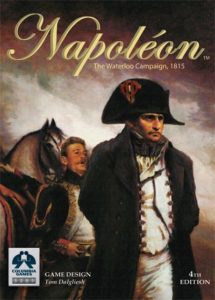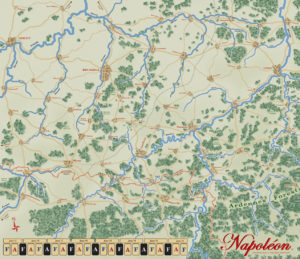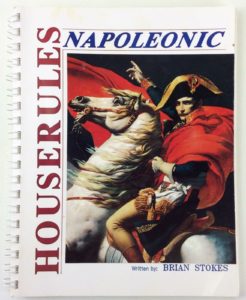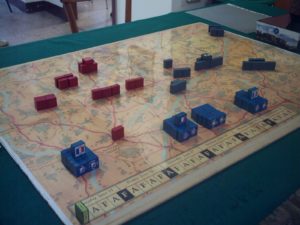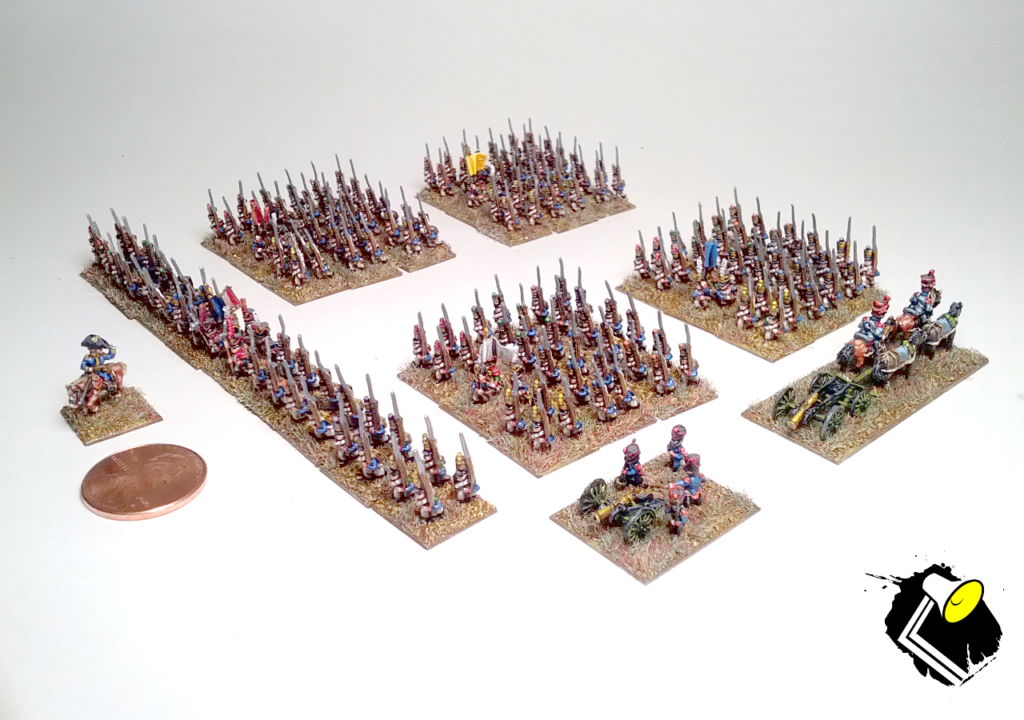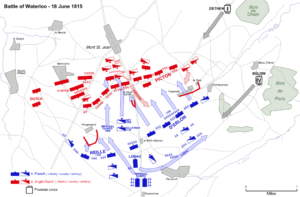By Dr. Richard M. M.D.
Introduction:
Columbia Games wooden block game “Napoleon” is a classic, and quite honestly my favorite board game of all time (and my memory stretches as far back as Tactics II).
Few games have achieved a strategic play that is so elegant in its simplicity. The wooden blocks provide uncomplicated but effective fog of war and step reduction. The mechanics are straightforward group activation for town-to-town movement, with road limits affected by crossing rivers, and can be learned in minutes. However, the free deployment, wide open map, faster speed for cavalry and horse artillery, as well as forced marches can lead to sweeping maneuvers that can take years to master. No two games are alike. It is a great strategy game.
When enough forces have coalesced and both commanders agree to a battle, the blocks are moved, with their step reductions, to a stylized battle mat. The subtle “paper/scissors/rock” differences of the Horse and Musket and Cannon era are preserved. The campaign map allows for reinforcements to be brought on adding to the tension. The movement of the blocks on to and across the “battlefield” have a tactile sense that no other board game can match. It gives a feel more akin to a miniature battle than any cardboard counter/tweezer game could possibly provide.
The Background:
As satisfying as these battles have been, and I’ve fought hundreds, I’ve always thought “How cool would it be if I could move this battle to the table top instead of this little mat?”. The game provides an instant order of battle, with effective fog of war and a definite strategic context. With a proper table top road network set up, the reinforcements arrive at times unknown to the enemy, and on the flanks rather than just as a general Reserve-“Hey, what’s the dust on that road mean?”. What more can you ask for in a campaign vehicle?
I have long been a fan (acolyte actually) of Brian Stokes’ “HouseRules Napoleonics (HRN)” which we are currently revising extensively and renaming “Soldats de l”Empire!(SdIE)”. I use these for miniature battles and decided to come up with a way to fight the entire Waterloo Campaign using these two excellent gaming systems. I love HRN/SdlE, as it allows really big battles to be fought with a true “Napoleonic” feel to them. Please understand, though, that my idea can be adapted to any miniature rules.
The Three Laws:
In general, I wanted to have the miniature battle be the center point of this project, the master if you will, and the campaign game the servant.
I therefore promulgated the Three Laws of “I, Campaign System” (with apologies to Isaac Asimov’s “I, Robot”):
1.) A campaign system exists to produce a miniature battle, and cannot allow the miniature battle to be overshadowed.
2.) A campaign system must obey the orders given it to fit the requirements of a miniature
battle.
3.) A campaign system must protect its own existence by allowing a simple transition to and from the table top battle, as long as such protection does not violate the First or Second Law.
My System:
There are three types of blocks in the “Napoleon” game, infantry, cavalry and artillery. In the campaign game they only exhibit the characteristics of their given type. I felt this was too restrictive for a table top battle (see the Second Law). You could generate a battle with 4 blocks, for instance, with 3 of them infantry and 1 artillery. With no cavalry, this would result in a pretty boring miniature encounter.
I decided that the infantry blocks, which represent a small corps or ½ of a larger corps, should follow the corps concept of providing a balanced force of all 3 arms to hold out for a day. I also decided that a cavalry block would likely represent a division, or corps, and should have some intrinsic horse guns. The artillery blocks represent the corps and army park artillery and therefore can be just guns.
Looking at the blocks, most of the infantry have 3 or 4 CV (Combat Values) or pips, and the cavalry are all 2 or 3 CV’s. To have a simple one for one transition from CV’s to table top units was too restrictive. A 3 CV infantry block with one infantry, one cavalry and one artillery unit would be pretty ridiculous.
I decided that a 2 for 1 transition for the infantry and cavalry would be better, meaning you would get 8 table top units for a full strength 4 CV block, 6 units for a 3 CV block, and 4 units for a 2 CV block. The artillery I treated differently, as will be seen.
I researched the Order of Battle for all three armies extensively and calculated what proportion of infantry, cavalry and artillery each had, and set about ensuring that the make up of the blocks in total would reflect these historic proportions.
For the 3 CV/6 unit infantry I felt that a proportion of 4 infantry, 1 cavalry and 1 artillery units was quite reasonable. The 4 CV/8 unit blocks would have 6 infantry, 1 cavalry and 1 artillery. The 2 CV cavalry blocks would have 4 units, so 3 cavalry and 1 horse battery seemed perfect. The 3 CV/6 unit cavalry blocks would have 5 cavalry and only 1 horse battery. This seems disproportionate, but it had to be, as I needed to save some of the historic horse batteries for the horse artillery blocks in the campaign game (see the Third Law).
Looking at the OOB it was clear that the artillery, since quite a bit was “doled out” to the infantry and cavalry blocks, did not have enough left to support the same 2 to 1 transition, so it would be a strict 1 CV to 1 battery ratio for them-but that is OK because they are meant to represent the larger 12# batteries.
It took a bit of work, but in the end my collection has 35 French line infantry units spread out among the 8 infantry blocks, 24 cavalry units, with 8 in the infantry blocks (one each) and the rest among the 4 cavalry blocks, and 28 artillery batteries spread out among all the blocks as noted above. With my 6mm Adler figure collection, at a 1:60 ratio, this reflects the historic OOB to within a few hundred muskets and sabers, and is dead on in guns. The Imperial Guard, Anglo-Allied and Prussian armies are all equally accurate. Now, granted, my infantry units at this ratio represent 1800-2100 men (i.e. 3-4 battalions) and so are large regiments (or small brigades), and the cavalry units represent 2 regiments, so essentially are brigades. This may seem big, but HRN supports this scale quite easily.
To accommodate players who prefer a less grand scale, all I have to do is change the ground scale from the 6mm (where 1 inch equals 100 yards) to the 15mm (1 inch equals 50 yards), the figure ratio to 1:30, and voila, I have infantry with large battalions (or small regiments), and cavalry regiments. Other than expanding the frontages the only thing I have to do with the artillery is determine how many batteries in total are brought to the table, and remove half of them to restore the proper gun to men ratio.
One neat aspect of making the blocks, especially the infantry, combined arms, is how to determine what a block with step-reductions (either from forced marching, or previous battles) can bring to the table top. I simply let the owning player decide which units they want. For example, say a battle is generated that has three 3 CV infantry blocks, all with 1 step loss (so are 2 CV blocks), and a 3 CV cavalry block with 1 step loss. Each infantry block has to choose 4 units out of the 6 it starts with. In this situation it would be silly to keep the intrinsic cavalry units, as the cavalry block can provide 3 or 4 cavalry units out of its 6 total. If it were me, and since I have minimal knowledge of my opponents OOB, I’d probably have two infantry blocks provide all 4 of their infantry units, one block provide 3 of its infantry units and 1 battery, and the cavalry show up with 3 cavalry units and a horse battery. That would provide 11 infantry units, 3 cavalry and 2 batteries. A pretty balanced force I think. Of course, these choices could be different if I have reinforcements available on the strategic map that would alter my thinking.
As always, I tend to make things needlessly complicated. Here are 2 much simpler methods:
A points system with some restrictions: If each CV on a block represents a set number of points, you can choose certain units based on a point value to represent it.
Or just total up the CV’s of all the blocks being brought to a battle and decide on a proper distribution among the three arms for both sides. For example, seven blocks, of whatever type, could have a total of 21 CV. Make the miniature force composition infantry/cavalry/artillery at ~70%/15%/15%. So for infantry 70% of 21 is 14-15 units, for cavalry and artillery 15% of 21 is 3 units each.
I believe that flexibility in going from the campaign vehicle to the miniature battle is a key concept (see the Second Law).
Your System:
But you don’t have to lose your mind and create the monster I did.
This can be done with anyone’s 15mm collection and chosen ruleset. You just have to look at what troops you have, make sure the proportions within each army, and head-to-head against each other, are reasonable, and start your battle.
My point here is, that you can use the proportions I have outlined above to generate a miniature battle from the Napoleon game, then use your collection of soldiers and chosen rule set to fight a battalion/regiment/brigade-whatever sized battle, convert the table top losses, and resume the campaign until the next battle is generated. Be creative and flexible and it will work.
And believe me, you don’t have to go berserk the way I did and represent every freaking unit in the campaign (I could literally put on Waterloo and Wavre simultaneously and still have Wellington’s Hanoverians pulling garrison duty and Blucher’s bloodied corps licking their wounds in my travel chest!). You are unlikely to have all eight French infantry blocks in battle at the same time, so why represent them all? Even at Waterloo the French Army (not including the Guard) was only one half of its starting strength. This was due to attrition from forced marches, losses at Quatre Bras and Ligny and Grouchy’s detached force. If you are likely to only need 50-60% of the total forces for any decisive miniature battle you don’t need to have the entire army painted up. And if you have to use your beautifully painted and favorite hussars instead of the historically accurate dragoons, who cares? Get to the table top and slug it out!
And you don’t even have to have British and Prussian armies. The strategic game makes no distinction between the armies, other than the French having a more unified command structure, which honestly was always true. If the miniature battle is fought with Austrian or Russian troops, who cares? As long as the forces brought to the table are a reasonable reflection of the two sides strategic situation, and the losses from that battle are reasonably reflected in the return to the campaign map, it makes no difference if the casualty markers left strewn about the table were uniformed in red, white, blue or green.
As for the miniature battle table set up, I use the “Age of Reason” Seven Years War rules “Sport of Kings” tactical map generator, but any map generating system can work, just alter the road network to accommodate the reinforcements-and make up some road dust markers (players seem to love that harbinger of death).
“Nothing but a battle lost can be half as melancholy as a battle won.”:
So now that you’ve had your battle and sated your bloodlust, how do you deal with the aftermath?
The last problem is converting the miniature battle results to step reductions for the blocks to resume the campaign. This honestly was the toughest part to deal with, but despite the Third Law, is of secondary importance. To preserve the integrity of the campaign game, though, this has to be brutal.
A battle fought on the tactical mat, barring a voluntary withdrawal (which by itself can cause large losses) ends when one side has one of its three columns empty of blocks. Since you usually shift units from column to column to keep the battle going there are usually significant losses before it ends-more than just one-third you might think at first. You could start a battle with seven blocks and end up on the losing end with only two left, and even the winner might be down to four or five out of eight to ten at the start. Having a corps/division/brigade morale “break” system is probably the easiest way to do this. If your cavalry corps/division has been broken, that block should be eliminated. If one half of your infantry forces are routed you lose one half of your infantry blocks, etc. It is hard to give concise recommendations that will cover all miniature rules, just remember if you have a battle that eventually involved 9-10 blocks and come out with 7 healthy blocks you are drastically altering the balance of the campaign game. While the generation of tabletop battles is the key motivation here the campaign has to matter as well.
Conclusion:
The beauty of this system is that the “Napoleon” game, adapted as above, provides an elegantly simple way to generate miniature battles that have some true context and meaning. To my mind, as I’ve said before, what more can you ask for from a campaign system?
You can contact Dick at this e-mail address. It will then be forwarded to him.
Views: 914
